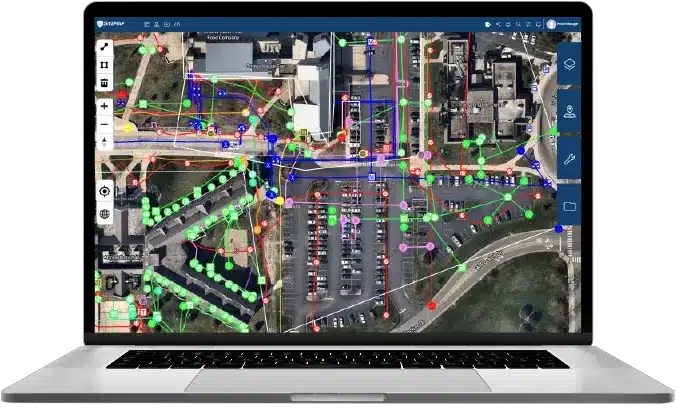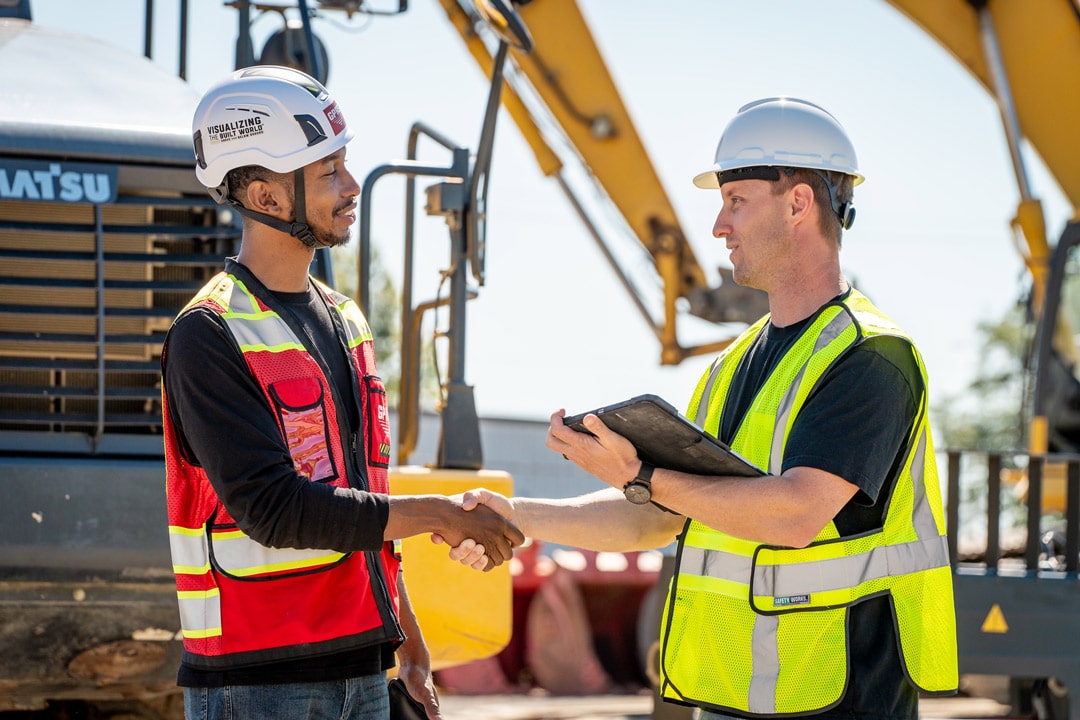The rat race is never ending. Its speed and demand require efficient operations for organizations seeking to remain competitive and agile. In correlation to this efficiency is the effective management of infrastructure assets, including utilities such as water, sewer, electricity, and telecommunications networks. SiteMap® (patent pending), powered by GPRS, is a comprehensive answer to the digital utility mapping solution question. What is the importance of infrastructure asset management and how is SiteMap® revolutionizing the way businesses map, monitor, and manage their utility infrastructure?
The Significance of Infrastructure Asset Management

Infrastructure assets form the pulse of modern society, providing essential services that enable businesses to operate, communities to thrive, and economies to grow. Effective management of these assets is essential for ensuring reliability, sustainability, and resilience in the face of evolving challenges such as aging infrastructure, population growth, and climate change.
While the cities aboveground continue to expand, the utilities below also continue to expand, creating a complex web of arteries and veins that essentially control the life above. Subsurface assets are the source of more than 80% of the energy in the U.S. today. Imagine what the nation would look like if even a quarter of those were mismanaged. It is because of this that the SubTER crosscut was created. The Subsurface Science, Technology and Engineering Research, and Development (SubTER) Crosscut is a collaboration across the Department of Energy (DOE) offices involved in research activities in energy production/extraction, subsurface storage, and environmental remediation.
Meeting energy challenges requires significant advances to ensure proper and affordable access to natural resources and storage in the subsurface. SubTER is set to improve access to subsurface resources and accelerate dynamic management of the subsurface by:
- Identifying subsurface challenges and advancing solutions
- Facilitating both intra-departmental and interagency collaboration of cross-cutting subsurface R&D activities
- Engaging industry stakeholders operating in the subsurface.
Managing subsurface assets is crucial to the continued success of our urban development. Without such development, our cities would become listless, communities would struggle to function, and basic amenities would practically cease to exist. It’s efforts like SubTER and platforms like SiteMap® that serve as the Energizer bunny for subsurface asset management.
Making The Grade

According to the American Society of Civil Engineers, the United States received a grade of C- for its infrastructure in 2021, which is up from a grade of D in 2017. This highlights the urgent need for investment and improvements in infrastructure management. Our $25 trillion U.S. economy practically relies on this subsurface infrastructure, which is outdated, and falling behind other advanced economies.
Relation To The Economy
Many economists will argue that continued and boosted investment in infrastructure in the twentieth century set the very foundation for the nation’s strong growth in the aftermath of the second world war. It’s this reliance on our infrastructure that can make or break the economy and the cities that depend on it.
A 2018 study found that delays caused by traffic congestion alone cost the economy over $87 billion dollars that year. Airports are another consideration: U.S. civil aviation directly supports 2.5 million U.S. jobs, and international tourism brings in up to $180 billion dollars in annual tax revenue. However, flight delays cost the U.S. economy billions of dollars yearly, including $33 billion in 2019, according to the Federal Aviation Administration.
There are plenty of analysts who say investing in both new infrastructure and current maintenance would stimulate the economy. This would boost long-term U.S. competitiveness, insulate the economy from unexpected shocks, and even create jobs. Many economists tend to view infrastructure management and spending as having a significant “multiplier effect.” This means that the gains are economically greater than the amount spent on the maintenance, management, and introduction.
A 2022 analysis by the World Bank found that for every single public dollar invested in our infrastructure, there was a result of $1.50 in economic activity, with an even bigger effect during a recession. Not only would proper investment in and management of our infrastructure help boost the economy, but we’re also running out of time before our problem becomes a bigger problem.
While the American Society of Civil Engineers upgraded our infrastructure grade slightly, we’re still in trouble, with much of our infrastructure assets degrading and crumbling, with many going completely undetected until it’s too late. The group estimated that there is an “infrastructure investment gap” of nearly $2.6 trillion during this decade alone. And that, if unaddressed, could cost the nation $10 trillion in lost GDP by the year 2039.
Transportation Tragedy
The transportation industry will require the largest demand of funding. One in three bridges needs to be repaired or replaced, this is according to the American Road and Transportation Builders Association. Further, 7% are structurally deficient. It doesn’t end there, as U.S. aviation infrastructure is also severely overburdened and mismanaged, with around 20% of all arrivals and departures delayed in 2022.
The nation’s rail systems aren’t to be left out. As for U.S. commercial rail, a large portion is owned by the private freight industry, with Amtrak sharing the lines, buying out rights to do so. This railway is among the most developed in the world. This railway system accounts for about 28% of the nation’s freight movement by ton-miles. At the same time, the focus on freight rail has relegated passenger rail to a lower priority. Amtrak, the United States’ main provider of intercity passenger rail, has an estimated repair backlog of more than $45 billion, according to the ASCE, which has resulted in federal grants being funded to try and save and improve the American cult favorite.
While these startling numbers aren’t toward our subsurface infrastructure, the subsurface does have an impact on every one of these aboveground resources and their infrastructure. Without proper subsurface maintenance, the aboveground infrastructure would fail, causing chaos, monetary disaster, and even fatalities across the nation.
Furthermore, proactive maintenance and optimization of infrastructure assets can result in significant cost savings and operational efficiencies for businesses, reducing the risk of unexpected failures and downtime.
Current Utility Infrastructure Stability
The subsurface isn’t faring any better than the above surface grade of infrastructure management and stability. The Environmental Protection Agency estimates that drinking water and wastewater systems will require at least $744 billion in additional investment over the next decade. The Flint Water Crisis is a prime example of the catastrophic consequences that can result from improper subsurface utility management. This crisis has yet to be fully resolved, leaving citizens without access to safe and clean drinking water.
It’s not just our waterways and water utilities that need help. Those in charge of the U.S. electrical grid are also struggling to make the necessary investments, causing increasing power outages that are costing the economy billions of dollars. If we ignore necessities, the internet is also at risk of falling victim to improper subsurface management. Depending on who you ask, the internet is quickly becoming a necessity required for work, school, communication, and general maintenance of many systems that keep the country functioning.
Many warn of the “broadband gap,” in which rural and low-income communities suffer from a lack of infrastructure that is meant to deliver reliable internet. A 2021 Federal Communications Commission report finds that more than fourteen million Americans lack access to any broadband network. The majority of these citizens live in rural areas. There are also other estimates which suggest that almost three times as many people lack access. Governors across the political spectrum identify internet access as a priority in their states, with thirty-four states and territories signing on to a federal initiative which will invest $45 billion in U.S. broadband by the year 2030.
Falling Behind
The United States has tended from time to time to lag behind others in the developed world. Some analysis shows that the quality of U.S. infrastructure, compared to its peers, is steadily declining over the past two decades. U.S. infrastructure spending ranks toward the bottom among Group of Twenty (G20) countries.
U.S. infrastructure performance is bringing consequences for businesses, workers, and travelers. For instance, American passenger trains average just half the speed of Europe’s high-speed rails. Airport rankings put only five U.S. airports in the top fifty of all airports worldwide, with the highest ranking, Seattle-Tacoma (Seatac), coming in all the way down at number eighteen.
The United States invests less in infrastructure than most of its first-world peers, including France, Germany, and Japan. This is while China spends ten times more than the United States by percentage of GDP. China’s flagship global infrastructure project, known as the Belt and Road Initiative, has sought to increase the country’s economic influence across the world.
In other words, infrastructure in the United States, both in terms of subsurface infrastructure and otherwise, is in danger. This is why GPRS has committed to accurately mapping the world below, so that we’re better able to manage and improve these assets before it’s too late.
The Role of SiteMap® in Infrastructure Asset Management

SiteMap® offers a comprehensive suite of digital utility mapping solutions designed to streamline infrastructure asset management, which helps businesses across many industries. By leveraging advanced technologies SiteMap® enables the ability to accurately map, monitor, and manage their utility infrastructure with precision and efficiency.
SiteMap® provides businesses with real-time visibility into their utility infrastructure, allowing them to identify potential issues and take proactive action to prevent downtime and service disruptions. By integrating 99.8% accurate data from GPRS, SiteMap® creates an accurate and easy to use centralized repository of infrastructure asset information, streamlining data management and access for project managers and their teams.
SiteMap’s high-resolution mapping capabilities enable managers to visualize the precise location, depth, and condition of underground utilities, reducing the risk of conflicts and damage during construction, urban planning, and excavation activities.
SiteMap® allows you to quickly access, view, and share your infrastructure data securely with subcontractors, engineers, and your team. All of your utility, structural, water & sewer, and facility information is uploaded into the SiteMap® Map Viewer and Digital Plan Room. You can document construction progress with our Progressive Capture (ProCap) service which utilizes 3D photogrammetry or 3D laser scanning to track the evolution of the site and document key project milestones. Virtual Tours like WalkThru 3D allow you to virtually walk-through a site or facility in minutes, take basic measurements, estimate clearances and distances, and add digital notes.
SiteMap® is a project & facility management software application that provides accurate existing condition documentation to protect your assets & people. Visualize your world as it’s being built with SiteMap®. Current GPRS customers all receive a complimentary SiteMap® Personal subscription with their utility locate.
The Greater Importance
Effective utility infrastructure management is vital for ensuring the smooth functioning of modern societies. The urgent need for efficient management practices to maximize the lifespan and performance of existing infrastructure assets. Furthermore, utility failures can have significant economic consequences, with the ASCE estimating that inadequate infrastructure costs families $3,300 per year. Additionally, utility disruptions pose risks to public safety and health, as evidenced by the estimated 240,000 water main breaks that occur annually in the United States, according to the Environmental Protection Agency (EPA). These statistics highlight the critical importance of proactive utility infrastructure management in ensuring the resilience, reliability, and sustainability of infrastructure networks.
The Benefits for Business

SiteMap®, offers a remarkable 99.8% accuracy rating for utility and concrete infrastructure mapping, providing unparalleled precision in mapping and managing underground and encased assets. This level of accuracy is instrumental for businesses in various industries, enabling them to make informed decisions and minimize risks associated with underground infrastructure. With SiteMap® and GPRS, businesses can confidently plan construction projects, avoid costly utility strikes, and ensure compliance with regulatory requirements.
Overall, SiteMap® and GPRS’s 99.8% accuracy rating for infrastructure mapping empowers businesses to achieve greater reliability, resilience, and success in their operations.
Proper infrastructure management offers a multitude of benefits to businesses across various sectors. It enhances operational efficiency by ensuring that infrastructure assets are utilized optimally, minimizing downtime, and reducing disruptions to business operations. Efficient infrastructure management also leads to cost savings by mitigating the need for frequent repairs and replacements, thereby improving the bottom line. The subsurface is more tied to the economy than most would believe. Overall, proper infrastructure management is essential for businesses to maintain competitiveness, achieve sustainable growth, and thrive in a rapidly evolving business landscape.
The nation’s utilities are at risk of near total incapacitation, and efficient operations are essential for businesses seeking to thrive in today’s competitive marketplace, with effective management of infrastructure assets being central to achieving this efficiency. If we fail to realize these issues, and if we fail to address them with proper and accurate subsurface asset management, we will fail the nation and our very foundation.
SiteMap® plays a crucial role in streamlining infrastructure asset management by providing easy to use visibility, high-resolution mapping, and advanced technologies and methodologies. By leveraging SiteMap’s digital utility mapping solutions, the nation can optimize their utility infrastructure, reduce downtime, and enhance operational efficiencies, ultimately driving success and growth in the modern business landscape. The subsurface is struggling, but it doesn’t have to. Take the first step in subsurface asset stability, contact SiteMap® today.
